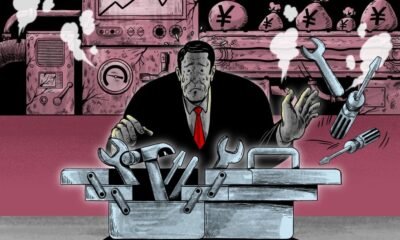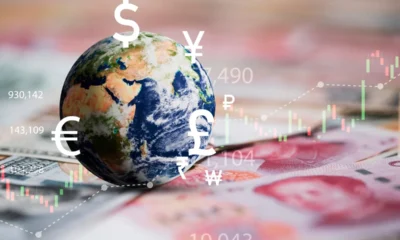Published
11 months agoon

RBI has swung into action, India’s GDP numbers for the second quarter were dismal, but let’s be honest—this slowdown didn’t come out of nowhere. Consumption trends have been warning us for a while now, and with government spending cooling off in the first half of the year, one of the major engines driving growth has slowed down significantly.
Thus, the recent slowdown in India’s GDP growth has shifted the Reserve Bank of India’s (RBI) focus from its long-standing battle against inflation to addressing faltering economic growth. This strategic pivot has sparked a legitimate debate and with the government aiming for an ambitious 8% annual growth, the big question is-Are we focusing on the right priorities. Is it the right call, or are we ignoring inflation at the cost of long-term stability?
That’s where the Reserve Bank of India (RBI) comes in. When the Monetary Policy Committee (MPC) meets from December 4-6, they’ll likely spend more time on boosting growth than curbing inflation. It’s a significant shift—one we haven’t seen in over 30 months. But is this shift necessary? Or is inflation still the real monster under the bed?
Consumption. The Cracks Are Showing
Urban consumption is slowing down. Sure, rural areas are showing some signs of recovery, but let’s be real—urban centers are the backbone of India’s economy. When they’re struggling, the whole system feels the pinch.
Why? The job market tells a grim story. Data from the RBI’s annual report shows that job growth in the organized sector has been almost non-existent over the past decade. In FY13, 447.9 lakh people were employed in this sector. By FY23, that number had barely budged to 457.2 lakh—a measly 0.2% growth per year. Shockingly, organized sector jobs were higher in FY16 than in FY23, signaling a deeper issue of “jobless growth.”
Income stagnation compounds the problem. According to AON Hewitt, annual increments have shrunk from robust double-digit growth to single-digit figures. Moreover, income disparity is widening as corporations channel substantial rewards to a few top performers, leaving the majority with minimal raises. This skewed income distribution has driven consumption in premium segments while mass-market demand dwindles—a worrisome trend for long-term economic sustainability.
The IT Sector
For years, the IT sector kept the job market alive, especially at the entry and junior levels, helping fuel urban consumption. But lately, even that engine is sputtering. While a revival in IT could provide some relief, it’s not enough to solve India’s broader problem of jobless growth.
What About Interest Rates?
India Inc. has been pushing hard for lower interest rates, with Finance Minister Nirmala Sitharaman and Commerce Minister Piyush Goyal leading the charge. But here’s the twist: the RBI isn’t budging just yet. Some economists are betting on a 50-basis-point cut in the repo rate from 6.5%, but others warn this might do more harm than good.
Blaming high interest rates for the slowdown might be missing the point. These same rates kept the economy humming for over two years.
The real issue now? Credit availability. Banks have tightened lending thanks to stricter RBI norms aimed at curbing risky loans and promoting financial stability. Loan growth has dropped to 11.15% from over 20%, choking off funds to businesses and consumers alike.

Why Growth Over Inflation?
Critics argue that inflation is eroding purchasing power, especially among lower- and middle-income households, and question why the RBI is not prioritizing its control. Yet, the RBI’s shift isn’t arbitrary; it is a response to broader economic challenges that transcend inflation.
Preventing a Recessionary Spiral: Prolonged weak growth could push the economy into a recession, affecting jobs, income, and consumption. The RBI aims to avoid this by stabilizing growth before it becomes a larger crisis.
Credit Availability vs. Interest Rates: The real issue isn’t high interest rates but the availability of credit. Loan growth has slowed from over 20% to 11.15%, as banks tighten lending norms. Easing credit flow could stimulate growth more effectively than a rate cut.
Investor Confidence: With corporate earnings under pressure, stabilizing growth helps restore investor confidence, which is crucial for long-term economic momentum.
The Risks of Ignoring Inflation
While the RBI’s growth-first strategy has merits, it comes with risks. Inflation disproportionately impacts vulnerable populations, eroding their purchasing power and deepening inequality. If inflation spirals out of control, the RBI may face a credibility crisis, necessitating drastic rate hikes later to regain control—potentially hurting both growth and inflation stability.
The RBI’s approach is a delicate balancing act between stimulating economic growth and managing inflation. Its success hinges on maintaining inflation within a manageable range while boosting credit availability. However, flexibility will be key. If inflation escalates, the RBI must pivot quickly to avoid long-term damage.
The Final Question


China To Cut Inflation Outlook To 20-Year Low, Eyes Fresh Stimulus At ‘Two Sessions’ To Boost Economy


Trump’s Latest Tariff Move on Mexico and Canada. Import Taxes Back on Track Hinting At A Full Blown Trade War!


Singapore Economy On A High. Annual GDP Expands At Fastest Pace Since 2021. Asian Markets Mixed Bag Reaction To Trump’s Reciprocal Tariffs


Global Economic Pulse, UK’s Surprise Growth, US Inflation Jumps While China And Japan Battle It Out—Who’s Leading And Who’s Lagging?


And The Trade Wars Begin…Disruptions Ahead! Trump’s Promise Of Tariffs Against Mexico, Canada, And China Comes To Fruition, But Not Without Retaliation. Multifold Economies to Be Affected


All About The Union Budget 2025-26—Worthy of Claps, Or Is There Something Lurking That We May Have Missed?
